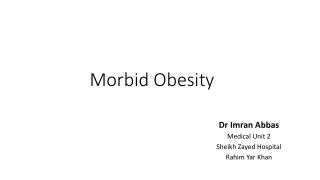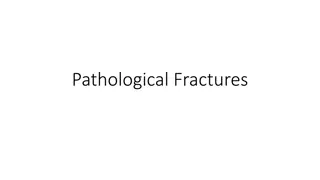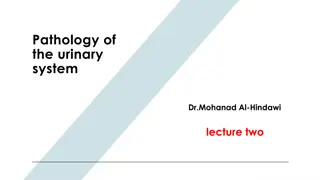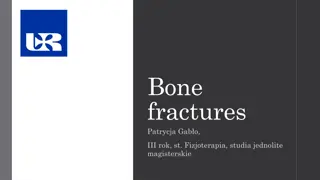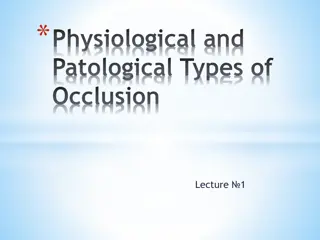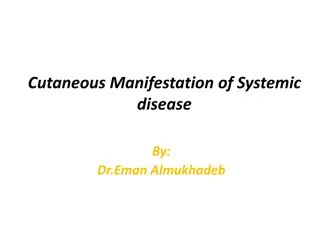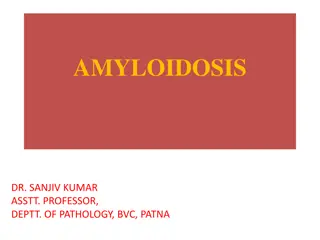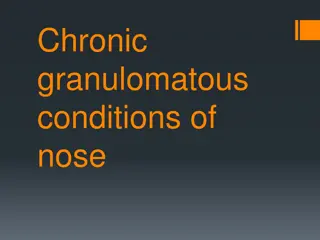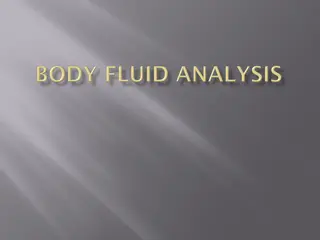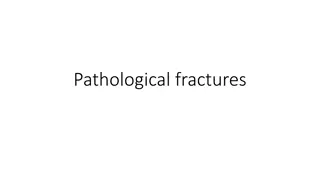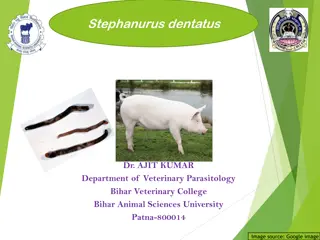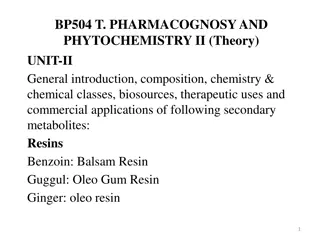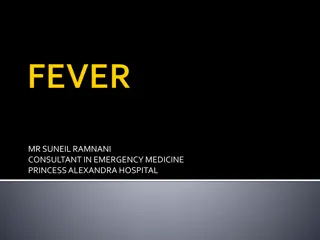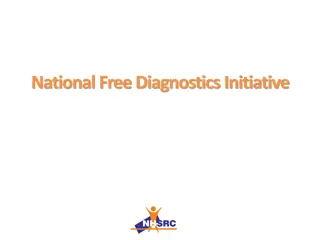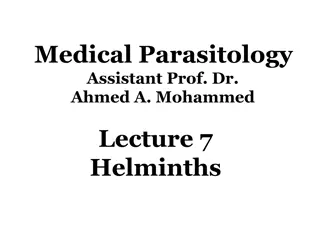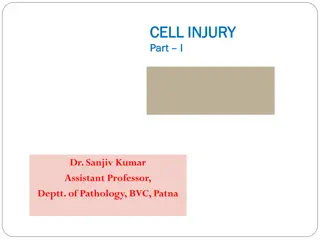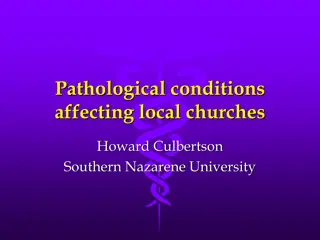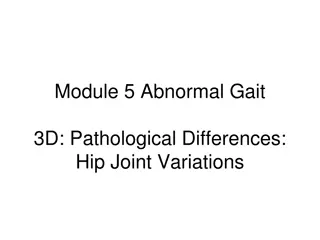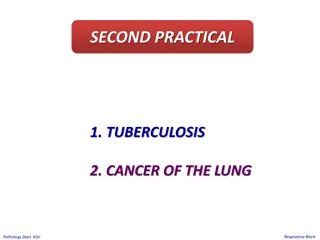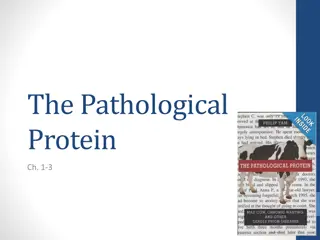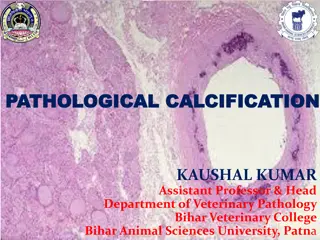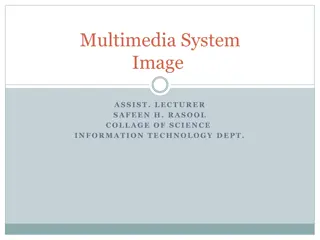Morbid Obesity
Morbid obesity, its definition, BMI, and the pathological consequences it has on health. Dr. Imran Abbas's medical unit at Sheikh Zayed Hospital in Rahim Yar Khan specializes in treating morbid obesity and related health conditions.
0 views • 24 slides
Pathology Acute kidney injury
Guidelines of renal biopsy, types of acute kidney injury, clinical manifestations, and pathological findings in this comprehensive lecture. Explore the normal anatomy and histology of the kidney, terminology, etiology, pathophysiology, and more.
7 views • 17 slides
Pathological Fractures
Pathological fractures occur in weakened bones due to underlying diseases or conditions, often manifesting with minimal trauma. Common causes include neoplastic lesions, infections, metabolic imbalances, and developmental disorders. Recognizing these fractures is crucial for timely intervention and
1 views • 20 slides
Pathology of the urinary system
Focal segmental glomerulosclerosis (FSGS) is characterized by sclerosis of some glomeruli, while membranous nephropathy (MN) involves subepithelial immunoglobulin deposits. FSGS can lead to end-stage renal disease, with poor response to corticosteroid therapy. MN, on the other hand, shows diffuse ca
1 views • 20 slides
Understanding Cellular Pathology: Response to Stress and Disease Predisposition
Explore the hallmarks of cellular pathology, including factors influencing disease predisposition such as genetics, environmental factors, and lifestyle. Delve into the cellular response to stress, adaptive and pathological reactions, and key stressors disrupting cellular homeostasis. Uncover how ce
0 views • 51 slides
Understanding Medical Terminology: Suffixes and Their Meanings
Dive into the realm of medical terminology suffixes and their significance in altering the meanings of terms. Explore various types of suffixes like grammatical, diagnostic, pathological, surgical procedure, and disease-related. Learn examples of noun suffixes and their definitions, shedding light o
2 views • 12 slides
Radiographic Imaging Methods of the Respiratory System
Radiographic imaging plays a crucial role in the evaluation and diagnosis of thoraco-mediastino-pleuro-pulmonary conditions. Techniques like radioscopy, digital radiography, computer tomography, magnetic resonance imaging, conventional pulmonary angiography, and hybrid imaging methods offer detailed
10 views • 21 slides
Bone Fractures
Bone fractures can occur due to external forces, high-energy trauma, bone fatigue, or underlying skeletal diseases. Symptoms include pain, tenderness, swelling, and difficulty moving. Different types of fractures include nondisplaced, displaced, compound, pathological, longitudinal, and spiral fract
0 views • 15 slides
Understanding Physiological and Pathological Types of Occlusion
This lecture discusses the physiological types of occlusion, focusing on facial and jaw signs to determine correct harmonious occlusion. It explains characteristics of orthognathic bite, straight bite, physiological biprognathism, and opisthognathic bite, highlighting key features such as tooth alig
1 views • 34 slides
Food spoilage
In this lecture from the Department of Pathological Analyses at the University of Basrah, Prof. Dr. Saad S. Mahdi Al-amaradi Al-Amara discusses food spoilage, focusing on cereals, bakery foods, and meat products. The presentation covers the microbial spoilage of grains, including common mold species
0 views • 9 slides
Cutaneous Manifestations of Systemic Diseases: Endocrine Disorders and Diabetes Mellitus
Explore the cutaneous manifestations of systemic diseases, particularly focusing on endocrine disorders like diabetes mellitus. Learn about the dermatologic signs associated with conditions such as hypothyroidism, hyperthyroidism, Addison's disease, and Cushing syndrome. Discover specific manifestat
0 views • 88 slides
Understanding Amyloidosis: Causes, Types, and Pathological Characteristics
Amyloidosis is a disorder characterized by the deposition of abnormal amyloid fibrils in tissues, impacting various organs. This condition is associated with different types of amyloid, such as AA and AL amyloid. The deposition of amyloid can lead to tissue damage and organ dysfunction. Primary and
1 views • 11 slides
Understanding Rhinoscleroma: A Chronic Granulomatous Condition of the Nose
Rhinoscleroma is a chronic granulomatous condition of the nose caused by infection with the bacterium rhinoscleromatis. It primarily affects the nasal cavity but can also involve other respiratory tract structures. The disease is contracted through inhalation and exhibits distinct pathological stage
0 views • 31 slides
Understanding Cerebrospinal Fluid Analysis
Explore the essential aspects of cerebrospinal fluid (CSF) analysis, from routine laboratory assays to interpretation of pathological conditions. Learn about CSF formation, normal parameters, and interpretation of lab results to diagnose various neurological conditions.
0 views • 76 slides
Understanding Cardiac Output and Venous Return in Cardiovascular Physiology
Cardiac output, stroke volume, end-diastolic and end-systolic volumes play vital roles in cardiovascular function. Factors affecting cardiac output include physiological conditions and pathological states like hyperthyroidism and myocardial infarction. Venous return, controlled by mechanisms like Fr
0 views • 27 slides
Understanding Biohazardous Waste Management
Biohazardous waste poses a threat to living organisms, particularly humans, due to biological hazards like medical waste or toxins. This waste includes categories such as solid, liquid, sharps, and pathological waste, each requiring proper segregation and disposal to minimize health risks. Learn abo
0 views • 15 slides
Understanding Fractures: Traumatic vs. Pathological and Modeling Options
Defining the distinction between traumatic and pathological fractures, exploring the relationship between non-traumatic fractures and underlying bone pathologies, and discussing modeling options for classifying fractures. Stress fractures, insufficiency fractures, and the causes of pathological frac
3 views • 8 slides
Understanding Stephanurus Dentatus: Kidney Worm of Pigs
Stephanurus dentatus is a parasitic worm that infects pigs, with an intricate life cycle involving earthworms as transport hosts. Transmission occurs through ingestion of larvae or infected earthworms, leading to various pathological effects, including subcutaneous nodules, cirrhosis, and organ dama
0 views • 13 slides
Understanding Resins: Composition, Occurrence, and Classification
Resins are solid/semisolid amorphous products with complex chemical composition and are found in plants, animals, and fossils. They contain essential oils, terpene products, and carboxylic acids. Resins occur as a result of normal metabolism or in response to injury, forming physiological or patholo
1 views • 37 slides
Collection of Images Featuring Notable Historical Figures
A compilation of images showcasing prominent historical figures such as Pol Pot, Adolf Hitler, and sociologist S. Cohen, including snapshots from various sources like Wikimedia, Google Images, and academic websites. The images are presented in a structured manner with accompanying metadata, possibly
0 views • 10 slides
Understanding Erythrocyte Sedimentation Rate (ESR)
Erythrocyte Sedimentation Rate (ESR) is a crucial indicator used in diagnosing and monitoring various health conditions. It measures the rate at which red blood cells settle in a test tube, providing insights into inflammation, infections, anemias, and other diseases. Factors affecting ESR include t
4 views • 24 slides
Understanding Fever: Causes, Assessment, and Management in Emergency Medicine
A temporary increase in core body temperature, aka fever, can be a response to various conditions, both physiological and pathological. It is a common complaint in emergency departments, with infections being a primary cause. Assessment involves looking into associated symptoms, duration, medical hi
0 views • 14 slides
National Free Diagnostics Initiative Overview
The National Free Diagnostics Initiative aims to provide essential diagnostic services free of cost in public health facilities, leveraging existing institutional structures. The initiative covers a range of pathological and radiological tests at different levels of care, with outsourcing for high-c
2 views • 20 slides
Overview of Ancylostoma duodenale (Hookworm) Infection
Ancylostoma duodenale, a parasitic worm causing Ancylostomiasis, is discussed in this lecture. The infection's distribution, morphology, life cycle, and pathology are detailed, emphasizing the impact on humans. The lifecycle stages, including egg production, larval development, and entry into the hu
0 views • 12 slides
Understanding Pathological Pigmentation: Causes and Effects
Pathological pigmentation involves the abnormal deposition of pigments in the body. It can be classified as exogenous or endogenous, with various sources and types of pigments. Melanin, one of the endogenous pigments, plays a crucial role in determining tissue color and can have protective functions
5 views • 23 slides
Understanding Cell Injury and Adaptation in Pathology
Rudolph Virchow's concept of disease starting at the cellular level highlights how cells constantly face challenges in maintaining homeostasis. The plasma membrane acts as a barrier against external stressors, but when cells face excessive physiological stresses or pathological stimuli, they adapt o
0 views • 16 slides
Understanding H&E Staining in Histology
H&E staining, a widely used histological technique, involves staining cell nuclei blue and cytoplasmic components pink to aid in tissue structure analysis. This method provides essential insights into normal and pathological tissue changes, assisting in diagnoses and further testing decisions. The p
0 views • 7 slides
Common Laboratory Techniques in Zoology - Urine and Stool Specimen Analysis
In the Biology Department at Al-Mustansiriyah University, students learn laboratory techniques for collecting and analyzing urine and stool specimens. The process involves random urine sample collection, urine tests for chemical components, urine culture, stool specimen analysis for pathological con
0 views • 10 slides
Addressing Pathological Conditions in Local Churches
Pathological conditions affecting local churches such as "Ethnic-itis," "Ghost town," and "People blindness" are discussed along with their symptoms and remedies. Solutions include transitioning to reflect the neighborhood, using circuit-riding pastors in rural churches, and celebrating cultural dif
1 views • 20 slides
Building an Active Region Database for Solar Irradiance Variability Using SDO Images
San Fernando Observatory (SFO) at California State University Northridge is leveraging ground-based and space-based images to fill data gaps in solar images and develop a database for studying Total Solar Irradiance (TSI) variability. By extracting active-region information from Solar Dynamics Obser
5 views • 21 slides
Pathological Differences in Hip Joint Variations: Abnormal Gait Analysis
Understanding pathological gait variations related to hip joint differences is crucial in gait analysis. Excessive sagittal, coronal, and transverse plane motions impact stance and swing phases, leading to deviations in gait patterns. Excess flexion, limited flexion, past retraction, excess adductio
0 views • 13 slides
Clinical and Pathological Staging Cases in Oncology
This collection highlights clinical and pathological staging cases in oncology, covering scenarios from colon, lung, bladder, and kidney cancer. Each case presents detailed information on tumor characteristics, lymph node involvement, metastasis status, and clinical stages. Images accompany the desc
0 views • 9 slides
Confidential Collection of Kaimoana Images
A collection of confidential images related to Kaimoana, showcasing various aspects and details. The images are meant to be used exclusively for authorized purposes. Please refrain from sharing or using the images without proper authorization.
0 views • 25 slides
Pulmonary Tuberculosis and Lung Cancer Images in Respiratory Pathology Dept. KSU
Images showcasing various aspects of pulmonary tuberculosis (TB) and lung cancer in the respiratory pathology department at KSU. The pictures include Ghon's complex, caseous necrosis, miliary TB, tuberculous granulomas, and more, providing visual insights into the conditions and their pathological m
0 views • 39 slides
Unveiling the Mysteries of Pathological Proteins
The Pathological Protein delves into the intriguing case of Stephen Churchill, a young man whose sudden decline and tragic death spark questions about his mysterious neurological condition. As the investigation unfolds, more puzzling cases emerge, shedding light on the enigmatic world of neurodegene
0 views • 21 slides
Understanding Pathological Calcification in Veterinary Pathology
Pathological calcification is the abnormal deposition of calcium salts in soft tissues, with two forms - dystrophic and metastatic calcification. Dystrophic calcification occurs in dying tissues, while metastatic calcification reflects a derangement in calcium metabolism. Dystrophic calcification ca
0 views • 11 slides
Developing Standardized Tango Environment with Docker for SKA Telescope Project
SKA project required a standardized Tango environment for development, testing, and continuous integration resulting in reference Docker images for Tango v9.3.3. Developed on Debian stable, these images include dependencies and follow best practices. The project, known as ska-docker, provides core i
0 views • 13 slides
Understanding Pathological Gambling: Diagnosis and Epidemiology
Pathological gambling, characterized by the inability to resist the urge to gamble despite severe consequences, is a progressively worsening disorder. This text discusses the diagnostic criteria for pathological gambling, its positive diagnosis according to DSM-IV-TR, and epidemiological data on the
0 views • 23 slides
Understanding Digital Images and Colors in Multimedia Systems
Digital images play a vital role in multimedia projects, requiring time and skills to design graphics. Each pixel in a digital image represents an intensity value. Different types of digital images like binary images and grayscale levels are explained along with the concept of color representation.
0 views • 22 slides
Images of School of Faculty of Social Sciences and Humanities at Universiti Teknologi Malaysia
This content showcases a series of images that represent the School of Faculty of Social Sciences and Humanities at Universiti Teknologi Malaysia. The images feature the title "Place your picture here" along with the school's name and details. These images provide a visual insight into the school's
0 views • 5 slides
